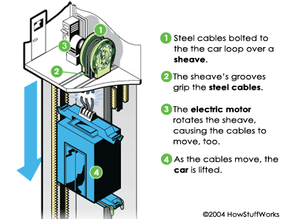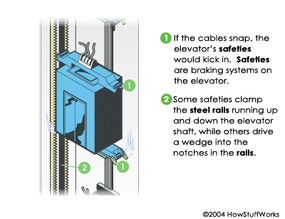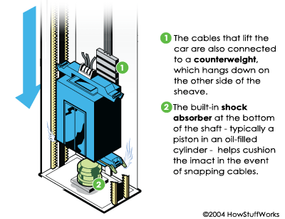
In November 2018, six people boarded an elevator at the former John Hancock Center in Chicago for the ride down from the Signature Room bar on the 95th floor to the lobby. But the long ride got a lot worse when one of the cables snapped and the elevator plunged 84 floors to the 11th floor.
"At the beginning I believed we were going to die," one of the passengers told CBS Chicago. "We were going down and then I felt that we were falling down and then I heard a noise – clack clack clack clack clack clack."
Advertisement
Amazingly, none of the passengers had to be hospitalized and there no serious injuries. The passengers thought they had only fallen a few floors. However, they did have to wait three hours to be rescued by firefighters because there were no openings between the floors [sources: CBS Chicago, Leone and Sobol].
So, how was it possible that one of the worst things that can happen to people in an elevator occurred and everyone survived? Action movies often show the hero getting in an elevator after the evil villain has cut the cables — and disaster ensues.
Fortunately, elevators in the real world have so many safety features that this kind of stuff usually never happens. Here's the breakdown:
Snapping Cables
In a cable elevator system, steel cables bolted to the car loop over a sheave. A sheave is a pulley with a grooved rim surface, at the top of the elevator shaft. The sheave's grooves grip the steel cables. So when an electric motor rotates the sheave, the cables move, too. The cables that lift the car are also connected to a counterweight, which hangs down on the other side of the sheave. The car and the counterweight both ride along on steel rails.
Each elevator cable is made from several lengths of steel material wound around one another. These cables very rarely snap, and inspectors regularly look at them for wear and tear. But even a steel cable can break. So what happens then?

Almost all pulley elevators have multiple cables -- between four and eight total. Even if one cable snapped, the remaining cables would hold the elevator car up. In fact, just one cable is usually enough.
Safeties and Governor
But let's say all the cables did snap. Then the elevator's safeties would kick in. Safeties are braking systems on the elevator car that grab onto the rails running up and down the elevator shaft. Some safeties clamp the rails, while others drive a wedge into notches in the rails. Typically, safeties are activated by a mechanical speed governor.

The governor is a pulley that rotates when the elevator moves. When the governor spins too fast, the centrifugal force activates the braking system.
At the Bottom
If the safeties failed, you would be plummeting rapidly, but you wouldn't quite be in a free fall. Friction from the rails along the shaft and pressure from the air underneath the car would slow the car down considerably (you would feel lighter than normal though). On impact, the car would stop and you would keep going, slamming you into the floor.

But two things would cushion the blow. First, the elevator car would compress the air at the bottom of the shaft as it fell, just as a piston compresses air in a bicycle pump. The air pressure would slow the elevator car down. Second, most cable elevators have a built-in shock absorber at the bottom of the shaft — typically a piston in an oil-filled cylinder. That would cushion the impact too. With all these features in place, you would have an excellent chance of surviving any elevator mishap.
In the case of the Chicago elevator incident, once the firefighters figured out where the passengers were, the crew put up struts to make sure the elevator did not drop any further. Then they broke a wall, forced the elevator door open and put a ladder into the elevator to help people up and out.
"We don't like to have to go through walls unless it's absolutely necessary," Chicago Fire Department spokesman Larry Langford told the Chicago Tribune. "The only other way to get to the elevator would have been ropes from the 97th floor, and that would not be safe. We don't come down like Batman so we must go through the wall."
Advertisement